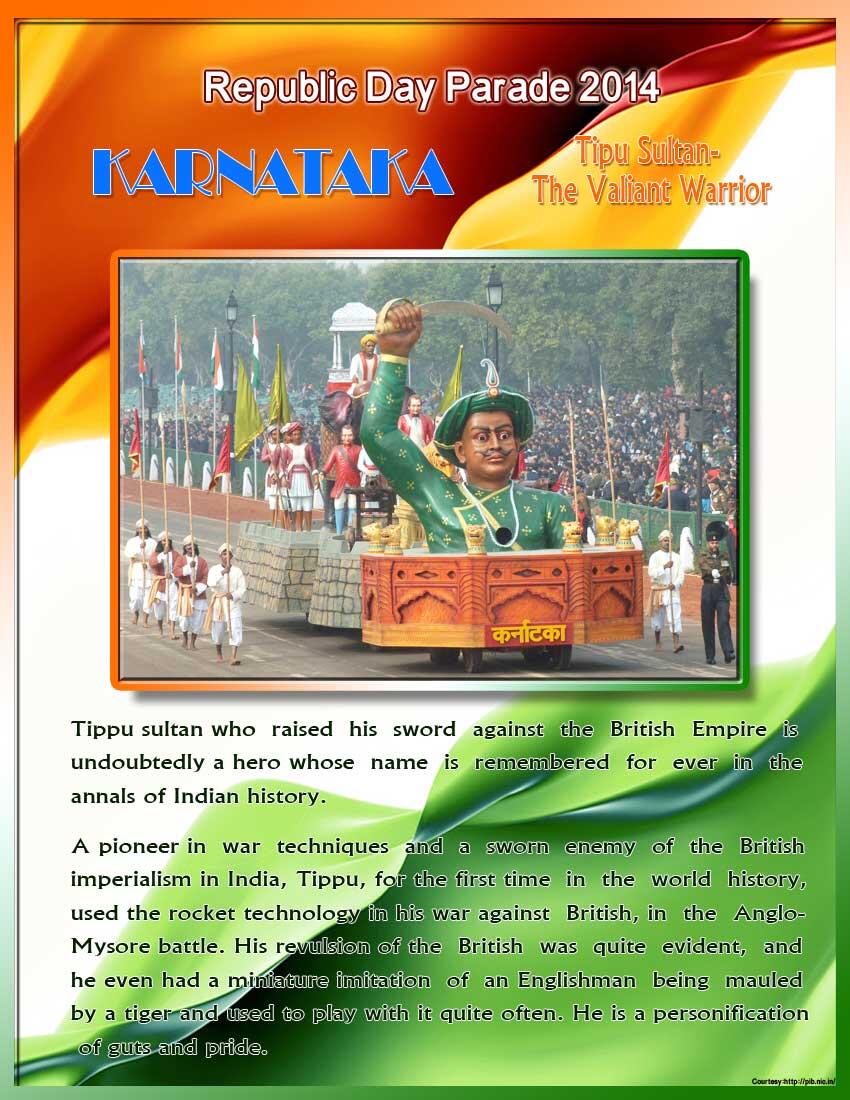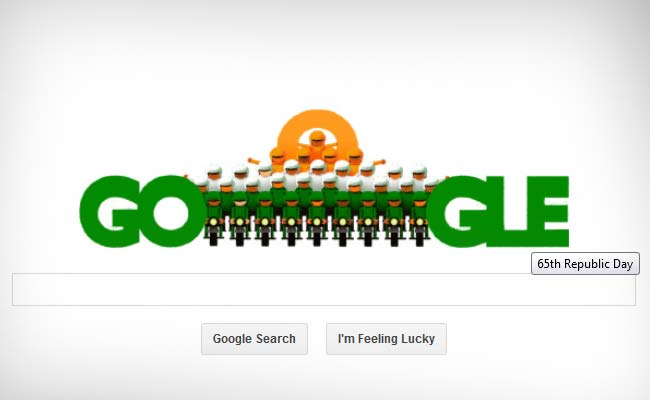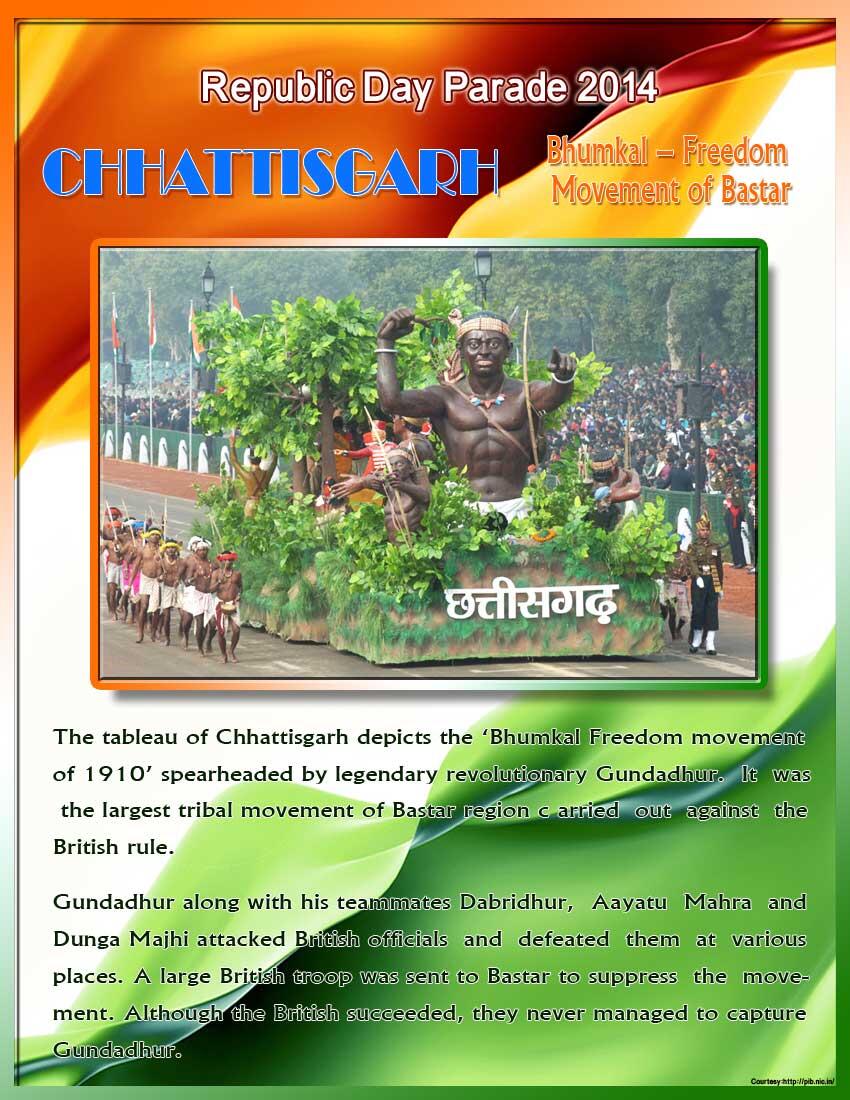65th Republic Day of India 26 January 2014 News Greetings Messages Quotes SMS Wallpaper
India celebrates its 65th Republic Day on Sunday 26 January 2014 with colourful display of India’s cultural heritage, man oeuvres by fighter aircraft and march past by armed forces graces the occasion during this year’s Republic Day parade. Around 25,000 police personnel, including from paramilitary forces and elite National Security Guards (NSG), have been deployed across the national capital.
Republic Day honours the date on which the Constitution of India came into force on 26 January 1950 replacing the Government of India Act (1935) as the governing document of India. The highlights of this year's Parade will be the display of India's first indigenously designed and developed Light Combat Aircraft Tejas. Tejas is a 4+ generation, supersonic, highly manoeuvrable, multi-role, smallest and lightest in its class contemporary combat aircraft designed for the Indian Air Force designed and developed by DRDO.
11:01 am: Tableau from Karnataka showcases the legend of Tipu Sultan.
11:00 am: Ladakhi culture showcased in Jammu-Kashmir tableau.
10.52 am: A tab of Arunachal Pradesh shows the Aji Lhamu dance – one of the most prominent folk dances of the state – at the Republic Day parade. The dance is for warding off the evil spirits.
10.50 am: A tableau of Uttar Pradesh depicting the splendour of sunrise in Banaras, its ghats and the banks of Ganga at the Republic Day parade.
10:45 am: Japanese PM witnesses India's Republic Day parade. Japanese Prime Minister Shinzo Abe on Sunday keenly witnessed the Republic Day parade at which he was the chief guest.
10.40 am: A tableau on unmanned systems by DRDO along with the Astra and Helina Missiles on the display at the Republic Day parade.
10.30 am: India’s Brass Brand of Border Security Force marches at Republic Day parade.
10.25 am: Army showcases its light combat aircraft Tejas.
10.10 am: Republic Day parade begins, President Pranab Mukherjee takes salute at Rajpath. 10.00 am: AP inspector Prasad Babu conferred Ashok Chakra.
9.50 am: President Pranab Mukherjee, Prime Minister Manmohan Singh and guest of Republic Day Japanese PM Shinzo Abe arrive at Rajpath escorted by bodyguards.
9.40 am: Prime Minister Manmohan Singh pays tribute to the martyrs at Amar Jawan Jyoti.
Since 1950, India has been hosting head of state or government of another country as the state guest of honour for Republic Day celebrations in New Delhi. During 1950-1954, Republic Day celebrations were organized at different venues (like Irwin Stadium, Kingsway, Red Fort and Ramlila Grounds). It was only starting 1955 when the parade in its present form was organized at Rajpath. The guest country is chosen after a deliberation of strategic, economic and political interests. During 1950s-1970s, a number of NAM and Eastern Bloc countries were hosted by India.
In the post-Cold War era, India has also invited several Western leaders on a state visit during the Republic Day. It is notable that before India fought bloody wars with China and Pakistan, leaders from these countries were invited as state guests for the Republic Day celebrations. Interestingly, Pakistan Food and Agriculture Minister was the second state guest from that country for Republic Day in 1965, a few days after which the two countries went to a war. Countries which have been invited multiple times include India's neighbours (Bhutan, and Sri Lanka), defence allies (Russia/USSR, France and Britain), trade partners (Brazil) and NAM allies (Nigeria and erstwhile Yugoslavia). France has the distinction of being the guest of honour for the maximum (four) number of times followed by three visits each from Bhutan, Mauritius and USSR/Russia.
India's 65th Republic Day is being marked with a Google doodle today. Daredevil motorcyclists, representing a unit of the armed forces, are seen carrying the doodle which has been painted in the colours of the Indian national flag.
To mark the importance of the occasion, every year a grand parade is held in the capital, New Delhi, from the Raisina Hill near the Rashtrapati Bhavan (the President's residence), along the Rajpath, past India Gate. Prior to its commencement, the Prime Minister lays a floral wreath at the Amar Jawan Jyoti, a memorial to unknown soldiers at the India Gate at one end of Rajpath, which is followed by two minutes silence in the memory of unknown soldiers. It is a solemn reminder of the sacrifice of the martyrs who died for the country in the freedom movement and the succeeding wars for the defence of sovereignty of their country. Thereafter he/she reaches the main dais at Rajpath to join other dignitaries, subsequently the President arrives along with the chief guest of the occasion. They are escorted on horseback by the President's Bodyguard.
The Constitution was passed by the Constituent Assembly of India on 26 November 1949 but was adopted on 26 January 1950 with a democratic government system, completing the country's transition toward becoming an independent republic. 26 January was selected for this purpose because it was this day in 1930 when the Declaration of Indian Independence (Purna Swaraj) was proclaimed by the Indian National Congress. It is one of three national holidays in India, other two being Independence Day and Gandhi Jayanti.
The main Republic Day celebration is held in the national capital, New Delhi, at the Rajpath before the President of India. On this day, ceremonious parades take place at the Rajpath, which are performed as a tribute to India.
India achieved independence from British rule on 15 August 1947 following the Indian independence movement noted for largely peaceful nonviolent resistance and civil disobedience led by the Indian National Congress. The independence came through the Indian Independence Act 1947 (10 & 11 Geo 6 c. 30), an Act of the Parliament of the United Kingdom that partitioned British India into the two new independent Dominions of the British Commonwealth (later Commonwealth of Nations): India and Pakistan.India obtained its independence on 15 August 1947 as a constitutional monarchy with George VI as head of state and the Earl Mountbatten as governor-general. The country, though, did not yet have a permanent constitution; instead its laws were based on the modified colonial Government of India Act 1935. On 28 August 1947, the Drafting Committee was appointed to draft a permanent constitution, with Dr.B. R. Ambedkar as chairman. While India's Independence Day celebrates its freedom from British Rule, the Republic Day celebrates the coming into force of its constitution.
The Beating Retreat ceremony officially denotes the end of Republic Day festivities. It is conducted on the evening of 29 January, the third day after the Republic Day. It is performed by the bands of the three wings of the military, the Indian Army, Indian Navy and Indian Air Force. The venue is Raisina Hills and an adjacent square, Vijay Chowk, flanked by the north and south block of the Rashtrapati Bhavan (President's Palace) towards the end of Rajpath.
The Chief Guest of the function is the President of India who arrives escorted by the (PBG), a cavalry unit. When the President arrives, the PBG commander asks the unit to give the National Salute, which is followed by the playing of the Indian National Anthem, Jana Gana Mana, by the Army developed the ceremony of display by the massed bands in which Military Bands, Pipe and Drum Bands, Buglers and Trumpeters from various Army Regiments besides bands from the Navy and Air Force take part which play popular tunes like Abide With Me, Mahatma Gandhi's favourite hymn, and Saare Jahan Se Achcha at the end.
Republic Day honours the date on which the Constitution of India came into force on 26 January 1950 replacing the Government of India Act (1935) as the governing document of India. The highlights of this year's Parade will be the display of India's first indigenously designed and developed Light Combat Aircraft Tejas. Tejas is a 4+ generation, supersonic, highly manoeuvrable, multi-role, smallest and lightest in its class contemporary combat aircraft designed for the Indian Air Force designed and developed by DRDO.
Highlights of 65th Republic Day Parade:
11:08 am: Chandigarh tableau showcases the city's famous Rock Garden.11:01 am: Tableau from Karnataka showcases the legend of Tipu Sultan.
11:00 am: Ladakhi culture showcased in Jammu-Kashmir tableau.
10.52 am: A tab of Arunachal Pradesh shows the Aji Lhamu dance – one of the most prominent folk dances of the state – at the Republic Day parade. The dance is for warding off the evil spirits.
10.50 am: A tableau of Uttar Pradesh depicting the splendour of sunrise in Banaras, its ghats and the banks of Ganga at the Republic Day parade.
10:45 am: Japanese PM witnesses India's Republic Day parade. Japanese Prime Minister Shinzo Abe on Sunday keenly witnessed the Republic Day parade at which he was the chief guest.
10.40 am: A tableau on unmanned systems by DRDO along with the Astra and Helina Missiles on the display at the Republic Day parade.
10.30 am: India’s Brass Brand of Border Security Force marches at Republic Day parade.
10.25 am: Army showcases its light combat aircraft Tejas.
10.10 am: Republic Day parade begins, President Pranab Mukherjee takes salute at Rajpath. 10.00 am: AP inspector Prasad Babu conferred Ashok Chakra.
9.50 am: President Pranab Mukherjee, Prime Minister Manmohan Singh and guest of Republic Day Japanese PM Shinzo Abe arrive at Rajpath escorted by bodyguards.
9.40 am: Prime Minister Manmohan Singh pays tribute to the martyrs at Amar Jawan Jyoti.
Since 1950, India has been hosting head of state or government of another country as the state guest of honour for Republic Day celebrations in New Delhi. During 1950-1954, Republic Day celebrations were organized at different venues (like Irwin Stadium, Kingsway, Red Fort and Ramlila Grounds). It was only starting 1955 when the parade in its present form was organized at Rajpath. The guest country is chosen after a deliberation of strategic, economic and political interests. During 1950s-1970s, a number of NAM and Eastern Bloc countries were hosted by India.
In the post-Cold War era, India has also invited several Western leaders on a state visit during the Republic Day. It is notable that before India fought bloody wars with China and Pakistan, leaders from these countries were invited as state guests for the Republic Day celebrations. Interestingly, Pakistan Food and Agriculture Minister was the second state guest from that country for Republic Day in 1965, a few days after which the two countries went to a war. Countries which have been invited multiple times include India's neighbours (Bhutan, and Sri Lanka), defence allies (Russia/USSR, France and Britain), trade partners (Brazil) and NAM allies (Nigeria and erstwhile Yugoslavia). France has the distinction of being the guest of honour for the maximum (four) number of times followed by three visits each from Bhutan, Mauritius and USSR/Russia.
India's 65th Republic Day is being marked with a Google doodle today. Daredevil motorcyclists, representing a unit of the armed forces, are seen carrying the doodle which has been painted in the colours of the Indian national flag.
To mark the importance of the occasion, every year a grand parade is held in the capital, New Delhi, from the Raisina Hill near the Rashtrapati Bhavan (the President's residence), along the Rajpath, past India Gate. Prior to its commencement, the Prime Minister lays a floral wreath at the Amar Jawan Jyoti, a memorial to unknown soldiers at the India Gate at one end of Rajpath, which is followed by two minutes silence in the memory of unknown soldiers. It is a solemn reminder of the sacrifice of the martyrs who died for the country in the freedom movement and the succeeding wars for the defence of sovereignty of their country. Thereafter he/she reaches the main dais at Rajpath to join other dignitaries, subsequently the President arrives along with the chief guest of the occasion. They are escorted on horseback by the President's Bodyguard.
The Constitution was passed by the Constituent Assembly of India on 26 November 1949 but was adopted on 26 January 1950 with a democratic government system, completing the country's transition toward becoming an independent republic. 26 January was selected for this purpose because it was this day in 1930 when the Declaration of Indian Independence (Purna Swaraj) was proclaimed by the Indian National Congress. It is one of three national holidays in India, other two being Independence Day and Gandhi Jayanti.
The main Republic Day celebration is held in the national capital, New Delhi, at the Rajpath before the President of India. On this day, ceremonious parades take place at the Rajpath, which are performed as a tribute to India.
India achieved independence from British rule on 15 August 1947 following the Indian independence movement noted for largely peaceful nonviolent resistance and civil disobedience led by the Indian National Congress. The independence came through the Indian Independence Act 1947 (10 & 11 Geo 6 c. 30), an Act of the Parliament of the United Kingdom that partitioned British India into the two new independent Dominions of the British Commonwealth (later Commonwealth of Nations): India and Pakistan.India obtained its independence on 15 August 1947 as a constitutional monarchy with George VI as head of state and the Earl Mountbatten as governor-general. The country, though, did not yet have a permanent constitution; instead its laws were based on the modified colonial Government of India Act 1935. On 28 August 1947, the Drafting Committee was appointed to draft a permanent constitution, with Dr.B. R. Ambedkar as chairman. While India's Independence Day celebrates its freedom from British Rule, the Republic Day celebrates the coming into force of its constitution.
The Beating Retreat ceremony officially denotes the end of Republic Day festivities. It is conducted on the evening of 29 January, the third day after the Republic Day. It is performed by the bands of the three wings of the military, the Indian Army, Indian Navy and Indian Air Force. The venue is Raisina Hills and an adjacent square, Vijay Chowk, flanked by the north and south block of the Rashtrapati Bhavan (President's Palace) towards the end of Rajpath.
The Chief Guest of the function is the President of India who arrives escorted by the (PBG), a cavalry unit. When the President arrives, the PBG commander asks the unit to give the National Salute, which is followed by the playing of the Indian National Anthem, Jana Gana Mana, by the Army developed the ceremony of display by the massed bands in which Military Bands, Pipe and Drum Bands, Buglers and Trumpeters from various Army Regiments besides bands from the Navy and Air Force take part which play popular tunes like Abide With Me, Mahatma Gandhi's favourite hymn, and Saare Jahan Se Achcha at the end.
Republic Day Greetings Messages Quotes SMS Wallpaper

Posted at 11:00 PM | Labels: 26 January 2014, greetings, india, jai hind, Messages, news, Proud to be an Indian, quotes, Republic Day, SMS, wallpaper | 0 Comments
Subscribe to:
Posts (Atom)
loading..
Popular Posts
-
November 1 Kerala Piravi, കേരള പിറവി, marks the birth of the state of Kerala, India . The state of Kerala was created on November 1, ...
-
Navratri is one of the very famous Festival of Hindus. It is dedicated to the worship of Goddess Durga, the deity of Power. Navratri Fes...
-
വറുതികള്ക്ക് വിട ചൊല്ലി ചിങ്ങ പൊന് പുലരി ആഗതമായ്. ഐശ്വര്യവും സമ്പല് സമൃദ്ധിയും നിറഞ്ഞ ഒരു പുതുവര്ഷത്തെ വരവേല്ക്കാന് മലയാളികള് ഒ...
-
Krishna Janmashtami, कृष्ण जन्माष्टमी, kṛṣṇa janmāṣṭami, also known as Krishnashtami, Saatam Aatham, Gokulashtami, Ashtami Rohini, Srikr...
-
Swamy Ayyappan, അയ്യപ്പന്, Sastavu or Sasta is a Hindu deity worshiped in a number of shrines across India. Ayyappan is believed to be ...
-
Vishu വിഷു is an important Kerala festival celebrated in the month of "Medam" and a Hindu festival in the Indian state of Ke...
-
Vishu, വിഷു is a Hindu festival celebrated in Kerala, India. It is an important festival in Kerala and it marks the beginning of the Ne...
-
ഹിജ്റ വർഷം ശവ്വാൽ മാസത്തിലെ ആദ്യ ദിവസമുള്ള ലോക മുസ്ലീംകളുടെ ആഘോഷമാണ് ഈദുൽ ഫിത്ർ അഥവാ ചെറിയ പെരുന്നാൾ . റമദാൻ വ്രതമനുഷ്ഠാനത്തിന്റെ പരിസമാ...
-
Uthradom , ഉത്രാടം, is the ninth and the penultimate day of the festival of Onam. It is considered as Onam eve and celebrated in...
-
Chinga Masam 2010 - Beginning of Harveset Fesetival Season in Kerala Chinga Masam is the first month in a traditional Malayalam calendar fol...

























